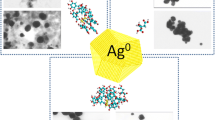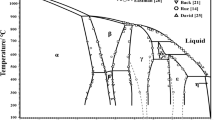Abstract
Based on the density functional theory (DFT) and time-dependent (TD) DFT methods, the geometric and spectroscopic features of (CuSe)n = 2–8 binary nanoclusters were systematically studied, and five kinds of isomers are obtained as local minima structures at each cluster size. The BHandH hybrid functional and effective core potential basis set LanL2DZ are used for copper atoms. The triple-ζ valence plus polarization basis set TZVP is selected for selenium atoms. For each cluster size, the relative energies of these five stable isomers are evaluated for the conformational isomerization. There are significant differences in infrared spectra between the isomeric structures, and the infrared spectra bands distinctly show differences in the low-frequency region between smaller size clusters and higher size clusters. The higher molar absorption coefficient is consistent with UV-Vis spectroscopy in the wavelength range of 200~400 nm. The calculated UV-Vis spectra clearly show that all clusters exhibit permissible excited electronic transitions in the range 0~10 eV. Therefore, these clusters can be used as potential UV-absorbing materials due to their strong UV absorption.







Similar content being viewed by others
References
Akbal F (2005) Photocatalytic degradation of organic dyes in the presence of titanium dioxide under UV and solar light: effect of operational parameters. Environ Prog 24(3):317–322
Ambade SB, Mane RS, Kale SS et al (2006) Chemical synthesis of p-type nanocrystalline copper selenide thin films for heterojunction solar cells. Appl Surf Sci 253(4):2123–2126
Baletto F, Ferrando R (2005) Structural properties of nanoclusters: energetic, thermodynamic, and kinetic effects. Rev Mod Phys 77(1):371–423
Bangal M, Ashtaputer S, Marathe S et al (2005) Semiconductor nanoparticles, IWNMS 2004. Springer, Berlin, pp 81–94
Bauernschmitt R, Ahlrichs R (1996) Treatment of electronic excitations within the adiabatic approximation of time dependent density functional theory. Chem Phys Lett 256(4–5):454–464
Becke AD (1988) Density-functional exchange-energy approximation with correct asymptotic behavior. Phys Rev A 38(6):3098–3100
Bernhardt T, Heiz U, Landman U (2007) Chemical and catalytic properties of size-selected free and supported clusters, Nanocatalysis. Springer, Berlin, Heidelberg, pp 1–191
Cheng X, Ding D, Yu Y et al (2013) Geometrical structures and electronic properties of copper-doped aluminum clusters. Chin J Chem Phys 25(2):169
Courtney CM, Goodman SM, McDaniel JA et al (2016) Photoexcited quantum dots for killing multidrug-resistant bacteria. Nat Mater 15(5):529
Dong D, Xiao-Yu K, Jian-Jun G, Ben-Xia Z (2010) Density functional theory study of AunMn (n=1-8) clusters. J Phys Chem Solids 71(5):770–775
Ferrando R, Jellinek J, Johnston RL (2008) Nanoalloys: from theory to applications of alloy clusters and nanoparticles. Chem Rev 108(3):845–910
Freund HJ (2002) Clusters and islands on oxides: from catalysis via electronics and magnetism to optics. Surf Sci 500(1–3):271–299
Frisch MJ et al (2009) Gaussian 09, Revision E.01. Gaussian Inc., Wallingford
Giribabu K, Suresh R, Manigandan R et al (2013) Aqueous based synthesis of Cu5Se4 nanosheets and characterization. J Mater Sci Mater Electron 24(6):1888–1894
Gomez L, Sebastian V, Arruebo M, Santamaria J, Cronin SB (2014) Plasmon-enhanced photocatalytic water purification. Phys Chem Chem Phys 16(29):15111–15116
Gosavi SR, Deshpande NG, Gudage YG, Sharma R (2008) Physical, optical and electrical properties of copper selenide (CuSe) thin films deposited by solution growth technique at room temperature. J Alloys Compd 448(1–2):344–348
Gross EKU, Dobson JF, Petersilka M (1996) Density functional theory of time-dependent phenomena[M]//density functional theory II. Springer, Berlin, Heidelberg, pp 81–172
Hay PJ, Wadt WR (1985a) Ab initio effective core potentials for molecular calculations. Potentials for the transition metal atoms Sc to Hg. J Chem Phys 82(1):270–283
Hay PJ, Wadt WR (1985b) Ab initio effective core potentials for molecular calculations. Potentials for K to au including the outermost core orbitals. J Chem Phys 82(1):299–310
He W, Wu X, Liu J, Hu X, Zhang K, Hou S, Zhou W, Xie S (2010) Design of AgM bimetallic alloy nanostructures (M=au, Pd, Pt) with tunable morphology and peroxidase-like activity. Chem Mater 22(9):2988–2994
Huber KP (2013) Molecular spectra and molecular structure: IV. Constants of diatomic molecules. Springer Science & Business Media
Iwasa T, Nakajima A (2013) Geometric, electronic, and optical properties of a boron-doped aluminum cluster of B2Al21 −: a density functional theory study. Chem Phys Lett 582:100–104
Jamorski C, Casida ME, Salahub DR (1996) Dynamic polarizabilities and excitation spectra from a molecular implementation of time-dependent density-functional response theory: N2 as a case study. J Chem Phys 104(13):5134–5147
Kim KS, Jeong HC, Cho JY et al (2003) Preparation of copper (cu) thin films by MOCVD and their conversion to copper selenide (CuSe) thin films through selenium vapor deposition. Bull Kor Chem Soc 24(5):647–649
Li G, Wang K, Wang Q, Zhao Y, du J, He J (2012) Formation of icosahedral and hcp structures in bimetallic co-cu clusters during the freezing processes. Mater Lett 88:126–128
Li YF, Kuang XY, Wang SJ, Li Y, Zhao YR (2011) Geometries, stabilities, and electronic properties of gold-magnesium (AunMg) bimetallic clusters. Phys Lett A 375(18):1877–1882
Liew JYC, Talib ZA, Mahmood W et al (2009) Structural, morphology and electrical properties of layered copper selenide thin film. Centr Eur J Phys 7(2):379–384
Liu Y, Yuan Y, Xiao C, Deng K (2013) Theoretical study on the magic character of In6Na2 cluster. Chem Phys Lett 583:131–136
Ma W, Chen F (2012) Optical and electronic properties of cu doped ag clusters. J Alloys Compd 541:79–83
Mane RS, Kajve SP, Lokhande CD, Han SH (2006) Studies on p-type copper (I) selenide crystalline thin films for hetero-junction solar cells. Vacuum 80(6):631–635
Pal R, Cui LF, Bulusu S, Zhai HJ, Wang LS, Zeng XC (2008) Probing the electronic and structural properties of doped aluminum clusters: MAl12 − (M=li, cu, and au). J Chem Phys 128(2):024305
Pathan HM, Lokhande CD, Amalnerkar DP, Seth T (2003) Modified chemical deposition and physico-chemical properties of copper (I) selenide thin films. Appl Surf Sci 211(1–4):48–56
Pawar RC, Pyo Y, Ahn SH et al (2015) Photoelectrochemical properties and photodegradation of organic pollutants using hematite hybrids modified by gold nanoparticles and graphitic carbon nitride. Appl Catal B Environ 176:654–666
Pradhan K, Sen P, Reveles JU et al (2008) First-principles study of TMNan (TM=Cr, Mn, Fe, co, Ni; n=4-7) clusters. J Phys Condens Matter 20(25):255243
Schäfer A, Huber C, Ahlrichs R (1994) Fully optimized contracted Gaussian basis sets of triple zeta valence quality for atoms Li to Kr. J Chem Phys 100(8):5829–5835
Sounderya N, Zhang Y (2008) Use of core/shell structured nanoparticles for biomedical applications. Recent Pat Biomed Eng 1(1):34–42
Su W, Qian P, Liu Y, Shen J, Chen NX (2010) First principle calculations of yttrium-doped palladium clusters. Comput Phys Commun 181(4):726–731
Venkataramanan NS, Sahara R, Mizuseki H, Kawazoe Y (2010) Titanium-doped nickel clusters TiNin (n=1-12): geometry, electronic, magnetic, and hydrogen adsorption properties. J Phys Chem A 114(15):5049–5057
Wadt WR, Hay PJ (1985) Ab initio effective core potentials for molecular calculations. Potentials for main group elements Na to Bi. J Chem Phys 82(1):284–298
Wang HQ, Kuang XY, Li HF (2010a) Density functional study of structural and electronic properties of bimetallic copper-gold clusters: comparison with pure and doped gold clusters. Phys Chem Chem Phys 12(19):5156–5165
Wang LM, Pal R, Huang W, Zeng XC, Wang LS (2010b) Observation of earlier two-to-three dimensional structural transition in gold cluster anions by isoelectronic substitution: MAun − (n=8-11; M=Ag, Cu). J Chem Phys 132(11):114306
Wang M, Qiu G, Huang X, du Z, Li Y (2009) Study of the size-dependent properties of ScnAl (n=1-14) clusters by density-functional theory. J Phys Condens Matter 21(4):046004
Wen JQ, Xia T, Zhou H, Wang JF (2014) A density functional theory study of small bimetallic PdnAl (n=1-8) clusters. J Phys Chem Solids 75(4):528–534
Yang A, Fa W, Dong J (2010) Magnetic properties of transition-metal-doped tubular gold clusters: M@Au24 (M=V, Cr, Mn, Fe, co, and Ni). J Phys Chem A 114(12):4031–4035
Funding
This study was supported by the Basic Research Fund of Modern College of Humanities and Sciences of Shanxi Normal University (2018JCYJ49).
Author information
Authors and Affiliations
Corresponding author
Ethics declarations
Conflict of interest
The authors declare that they have no conflict of interest.
Rights and permissions
About this article
Cite this article
Zhang, J., Li, X. The geometric and spectroscopic features of (CuSe)n = 2–8 binary nanoclusters: a theoretical study. J Nanopart Res 20, 292 (2018). https://doi.org/10.1007/s11051-018-4404-2
Received:
Accepted:
Published:
DOI: https://doi.org/10.1007/s11051-018-4404-2




